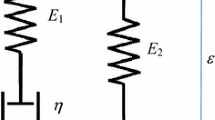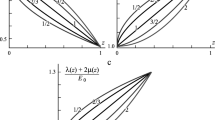Abstract
On the basis of the classical theory of thin anisotropic laminated plates the article analyzes the free vibrations of rectangular cantilever plates made of fibrous composites. The application of Kantorovich's method for the binomial representation of the shape of the elastic surface of a plate yielded for two unknown functions a system of two connected differential equations and the corresponding boundary conditions at the place of constraint and at the free edge. The exact solution for the frequencies and forms of the free vibrations was found with the use of Laplace transformation with respect to the space variable. The magnitudes of several first dimensionless frequencies of the bending and torsional vibrations of the plate were calculated for a wide range of change of two dimensionless complexes, with the dimensions of the plate and the anisotropy of the elastic properties of the material taken into account. The article shows that with torsional vibrations the warping constraint at the fixed end explains the apparent dependence of the shear modulus of the composite on the length of the specimen that had been discovered earlier on in experiments with a torsional pendulum. It examines the interaction and transformation of the second bending mode and of the first torsional mode of the vibrations. It analyzes the asymptotics of the dimensionless frequencies when the length of the plate is increased, and it shows that taking into account the bending-torsion interaction in strongly anisotropic materials type unidirectional carbon reinforced plastic can reduce substantially the frequencies of the bending vibrations but has no effect (within the framework of the binomial model) on the frequencies of the torsional vibrations.
Similar content being viewed by others
References
T. A. Weisshaar and B. L. Foist, “Vibration tailoring of advanced composite lifting surfaces.” J. Aircraft,22, No. 2, 141–147 (1985).
M. H. Shirk, T. J. Hertz, and T. A. Weisshaar, “Aerolastic tailoring theory. practice, promise,” J. Aircraft,23, No. 1, 6–18 (1986).
T. A. Weisshaar, “Aircraft aerolastic design and tailoring with advanced composite materials,” in: Work-book for the First USSR-US Symposium on Mechanics of Composite Materials [in Russian], Riga (1989), pp. 210–219.
V. E. Yudin, V. P. Volodin, and I. V. Kenunen, “Evaluation of the viscoelastic properties of the matrix in fibrous composite material by the method of freely attenuated torsional vibrations,” Mekh. Kompozitnykh Materialov, No. 3, 542–546 (1991).
V. S. Ekel'chik, A. A. Perren, V. M. Ryabov, and B. A. Yartsev, “The resonance method of determining the elastic characteristics of anisotropic rods made of composites, with flexural-torsional interaction taken into account,” in: Nondestructive Quality Control and Diagnostics of the Properties of Composites and Products Made From Them. Papers [in Russian], Riga (1991), pp. 128–139.
J. E. Ashton and M. E. Waddoups, “Analysis of anisotropic plates,” J. Composite Materials, No. 3, 148–165 (1969).
D. Mohan and H. B. Kingsbury, “Free vibrations of generally orthotropic plates,” J. Acoustical Soc. America.50, 266–269 (1971).
R. S. Nair and S. Durvasula, “Vibration of generally orthotropic skew plates,” J. Acoustic Soc. America,55, 998–1002 (1974).
R. R. Clary, “Vibration characteristics of unidirectional filamentary composite material panel,” in: Composite Materials: Testing and Design (2nd Conf.), ASTM STP 497, Amer. Soc. for Testing and Materials (1972), pp. 141–147.
E. A. Thornton and R. R. Clary, “A correlation study of finite-element modelling for vibrations of composite material panels,” in: Composite Materials: Testing and Design (3rd Conf.), ASTM STP 546, Amer. Soc. for Testing and Materials (1974), pp. 111–129.
E. P. Crawley, “The natural modes of graphite-epoxy cantilever plates and shells,” J. Composite Materials,13, 195–205 (1979).
E. P. Crawley and J. Dugundji, “Frequency determination and nondimensionalization for composite cantilever plates,” J. Sound Vibration,72, No. 1, 1–10 (1980).
D. W. Jensen, E. P. Crawley, and J. Dugundji, “Vibration of cantilevered graphite/epoxy plates with bending-torsion coupling,” J. Reinforced Plastics Composites,1, 253–269 (1982).
D. W. Jensen and E. P. Crawley, “Frequency determination techniques for cantilevered plates with bending-torsion coupling,” Amer. Institute Aeronautics Astronautics J.22, No. 3, 415–420 (1984).
G. A. Oyibo and J. Bentson, “Exact solutions to the oscillations of composite aircraft wings with warping constraint and elastic coupling,” AIAA J.,28, No. 6, 1075–1081 (1990).
Y. Narita and A. W. Leissa, “Frequencies and mode shapes of cantilevered laminated composite plates,” J. Sound Vibration,154, No. 1, 161–172 (1992).
S. Thangjitham and L. Librescu, “Vibration characteristics of anisotropic composite wing structure,” in: AIAA-91-1185-CP, a Collection of Technical Papers. AIAA/ASME/ASCE/AHS/ASC. 32nd Structures, Structural Dynamics and Materials Conf., Part 3 (1991), pp. 2115–2122.
Zh. R. Vinson and R. L. Sirakovskii, Behavior of Composite Materials Structures [in Russian], Moscow (1991).
E. Reissner and M. Stein, Torsion and Transverse Bending of Cantilever Plates, NACA TN 2369 (1951).
L. G. Ritchie, H. E. Rosinger, and W. H. Fleury, “The dynamic, elastic behavior of a fiber-reinforced composite sheet. II. The transfer matrix calculation of the resonant frequencies and vibration shapes,” J. Phys D: Appl. Phys.,8, No. 15, 1750–1768 (1975).
C.-L. Tsai, I. M. Daniel, and G. Yaniv, “Torsional response of rectangular composite laminates,” J. Appl. Mechanics,57, 383–387 (1990).
J. M. Whitney, Stress analysis of laminated anisotropic plates subjected to toisional loading, in: AIAA-91-0956-CP, a Collection of Technical Papers. AIAA/ASME/ASCE/AHS/ASC, 32nd Structures, Structural Dynamics and Materials Conf., Part 1 (1991), pp. 956–962.
M. V. Gershberg and V. S. Ekel'chik, “Vibration method of determining the shear moduli of orthotropic materials,” in: Properties of Polyester Glass Reinforced Plastics and Methods of Testing Them [in Russian], Leningrad (1967). pp. 184–206.
J. K. Suresh, C. Venkatesan, and V. Ramamurti, “Structural dynamic analysis of composite beams J. Sound Vibration,143, No. 3, 503–519 (1990).
V. S. Ekel'chik, V. M. Ryabov, and B. A. Yartsev, “Coupled bending-torsional vibrations of anisotropic polymer composite rods. 1. Theoretical analysis of the effect of anisotropy of the material and of the geometry of the rod on the natural frequencies,” Mekh. Kompozitnykh Materialov, No. 6, 998–1004 (1991).
W. P. Brown, “Interpretation of torsional frequencies of crystal specimens,” Phys. Rev., 2nd Ser.,58, No. 11, 998–1001 (1940).
A. W. Leissa, “On a curve veering aberration,” Zeitschrift für angewandte Mathematik und Physik,25, 99–111 (1974).
Additional information
Institute of Engineering Science Russian Academy of Sciences, St. Petersburg, Russia. St. Petersburg State University, Russia. Translated from Mekhanika Kompozitnykh Materialov, Vol. 32, No. 6, pp. 759–769, November–December, 1996.
Rights and permissions
About this article
Cite this article
Skel'chik, V.S., Ryabov, V.M. Various methods of determining the natural frequencies and damping of composite cantilever plates. 1. Exact solution for the binomial model of deformation. Mech Compos Mater 32, 524–531 (1996). https://doi.org/10.1007/BF02280634
Received:
Issue Date:
DOI: https://doi.org/10.1007/BF02280634




